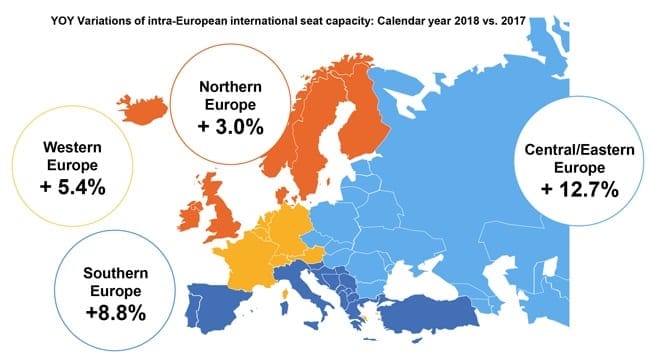When thinking about airports in Europe, most travel professionals are thinking about London Heathrow, FRAPORT, Munich, Paris De Gaulle.
However, Europe’s regional airports are becoming more and more popular with direct connection. Airlines like Lufthansa for years used a slogan: “Nonstop us”
Regional airports have been receiving a boost that can be attributed to specific events like the 2018 FIFA World Cup in Russia, but other long-term factors are at play, like the growing popularity of travel, increasing pressure on the major airports, human curiosity to keep discovering new places and the success of low-cost airlines.
According to the World Travel & Tourism Council (WTTC), the direct economic contribution of European regional travel was up 3.8% in 2017. That is significantly faster than the overall GDP growth of the EU, which was only up 2.3%.
Encouragingly for the economy, intra-European international seat capacity is growing fast, in the face of ever-increasing demand. In 2018, intra-European seat capacity is up 6.0% on last year. The growth has been strongest in Central/Eastern Europe, up 12.7%. In Southern Europe, it is up 8.8%; in Western Europe, it is up 5.4% and in Northern Europe, it is up 3.0%.
As well as Russia developing a regional capacity for the World Cup, Georgia was up 23%, Ukraine 18%, Poland 17% and Latvia 16%. They were the top-growing countries this year. And in southern Europe, Turkey and Greece both bounced back.
Many regional airports across Europe showed significant growth in terms of intra-European capacity. Regional airports like Aarhus, Bordeaux, Ufa and Antalya are top performers within their respective sub-regions. Russia has ambitious expansion plans for its regional airports, taking advantage of the momentum from the World Cup.
In 2018, seat capacity to long-haul destinations from Europe is up even more – by 9.1%, although the seat volume of long-haul flights is substantially less than that on intra-regional flights. It was the smaller European airports where capacity grew quickest, with the ten largest European airports showing slower growth.
One graphic example of the enthusiasm for travel comes from Valencia, showing residents’ flight searches for destinations not yet served. Top of the list are, in order, Athens, Florence, Kiev and Stockholm. Olivier Jager concluded: “We have observed thousands of searches for each of these destinations this year. That shows how much people want to depart from their local airport and they are constantly seeking new destinations. It’s both a challenge and a business opportunity that needs to be met.”
WHAT TO TAKE AWAY FROM THIS ARTICLE:
- Regional airports have been receiving a boost that can be attributed to specific events like the 2018 FIFA World Cup in Russia, but other long-term factors are at play, like the growing popularity of travel, increasing pressure on the major airports, human curiosity to keep discovering new places and the success of low-cost airlines.
- As well as Russia developing a regional capacity for the World Cup, Georgia was up 23%, Ukraine 18%, Poland 17% and Latvia 16%.
- Encouragingly for the economy, intra-European international seat capacity is growing fast, in the face of ever-increasing demand.






















